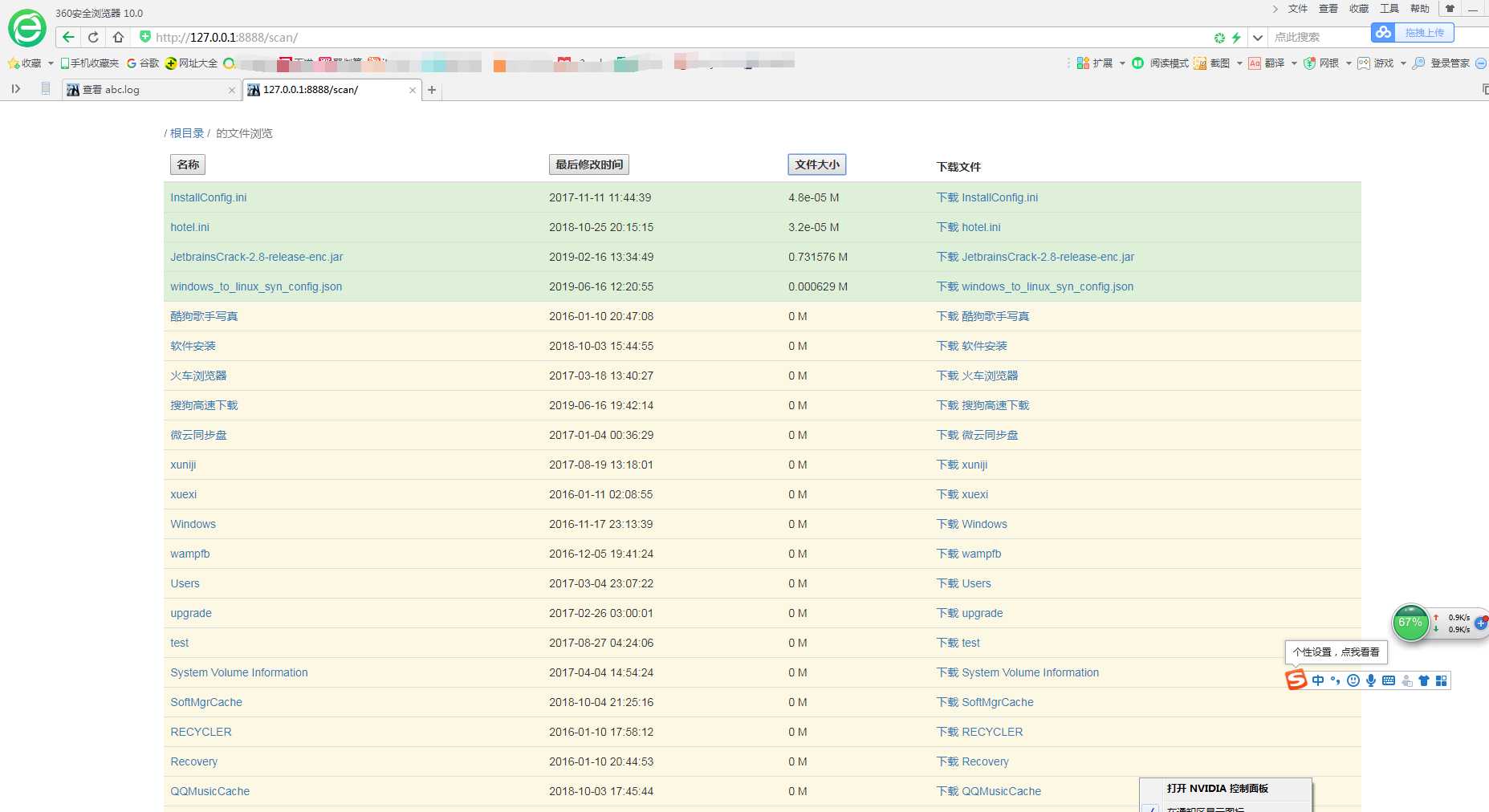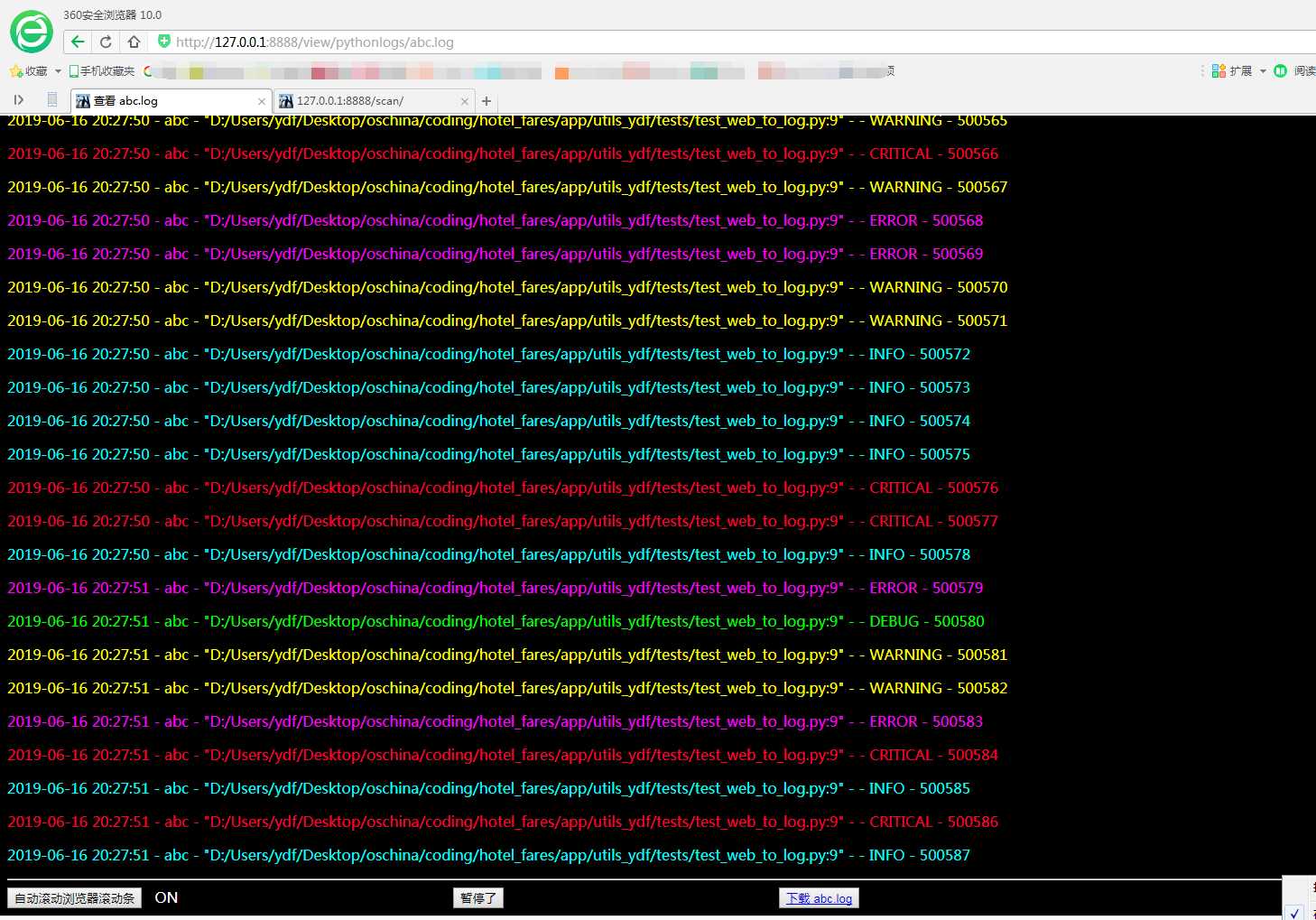使用py 和flask 实现的日志文件实时显示到网页的功能 + 系统文件夹浏览下载功能。
Posted ydf0509
tags:
篇首语:本文由小常识网(cha138.com)小编为大家整理,主要介绍了使用py 和flask 实现的日志文件实时显示到网页的功能 + 系统文件夹浏览下载功能。相关的知识,希望对你有一定的参考价值。
看日志希望带有彩色,希望从浏览器上看到,不用连到机器上看。
浏览系统的文件夹,scan + 系统文件夹的层级名字当做url路由,可以深层次看到机器上任何层级的文件夹。
如果是点击文件夹进入子目录。
如果是点击文件,尝试以文本格式读取文件,并以实时更新的方式显示到浏览器日志控制台并加彩。 主要是要做到不遗漏推送日志和不重复推送日志,采用的是python 操作文件的seek和tell。
浏览系统目录和下载文件的页面

查看实时日志更新的页面,提供了暂停功能和自动下拉功能。把日志根据级别加了彩色,更容易观察哪些是严重的,哪些是debug的。

实现代码。
# -*- coding: utf-8 -*- # @Author : ydf # @Time : 2019/6/14 17:33 import os from pathlib import Path from flask import Flask, send_from_directory, url_for, jsonify, request, render_template, current_app, abort, g, send_file from flask_httpauth import HTTPBasicAuth from flask_bootstrap import Bootstrap from app.utils_ydf import LogManager, nb_print, time_util print(str((Path(__file__).parent / Path(‘ydf_dir‘)).absolute())) app = Flask(__name__, template_folder=str((Path(__file__).parent / Path(‘ydf_dir‘)).absolute())) app.config[‘JSON_AS_ASCII‘] = False app.config[‘REFRESH_MSEC‘] = 1000 auth = HTTPBasicAuth() LogManager(app.logger.name).get_logger_and_add_handlers() bootstrap = Bootstrap(app) @app.route(‘/favicon.ico‘) def favicon(): print(Path(__file__).parent / Path(‘ydf_dir/‘).absolute()) return send_from_directory(str(Path(__file__).parent / Path(‘ydf_dir/‘).absolute()), ‘log_favicon.ico‘, mimetype=‘image/vnd.microsoft.icon‘) @app.route("/ajax0/<path:fullname>/") def info0(fullname): fullname = f‘/fullname‘ position = int(request.args.get(‘position‘)) current_app.logger.debug(position) # if os.path.isfile(full_name): # fo = open(full_name,encoding=‘utf8‘) # content = fo.read() # return content # else : # return "There is no log file" with open(fullname, ‘rb‘) as f: try: if position == 0: f.seek(-50000, 2) else: f.seek(position, 0) except Exception: current_app.logger.exception(‘读取错误‘) f.seek(0, 0) content_text = f.read().decode() # nb_print([content_text]) content_text = content_text.replace(‘\\n‘, ‘<br>‘) # nb_print(content_text) position_new = f.tell() current_app.logger.debug(position_new) # nb_print(len(content_text)) return jsonify(content_text=content_text, position=position_new) @app.route("/ajax/<path:fullname>/") def info(fullname): fullname = f‘/fullname‘ position = int(request.args.get(‘position‘)) current_app.logger.debug(position) # if os.path.isfile(full_name): # fo = open(full_name,encoding=‘utf8‘) # content = fo.read() # return content # else : # return "There is no log file" with open(fullname, ‘rb‘) as f: try: if position == 0: f.seek(-50000, 2) else: f.seek(position, 0) except Exception: current_app.logger.exception(‘读取错误‘) f.seek(0, 0) lines = f.readlines() content_text = ‘‘ for line in lines: line = line.strip().decode() if ‘- DEBUG -‘ in line: color = ‘#00FF00‘ elif ‘- INFO -‘ in line: color = ‘#00FFFF‘ elif ‘- WARNING -‘ in line: color = ‘yellow‘ elif ‘- ERROR -‘ in line: color = ‘#FF00FF‘ elif ‘- CRITICAL -‘ in line: color = ‘#FF0033‘ else: color = ‘‘ content_text += f‘<p style="color:color"> line </p>‘ # content_text = f.read().decode() # # nb_print([content_text]) # content_text = content_text.replace(‘\\n‘, ‘<br>‘) # # nb_print(content_text) position_new = f.tell() current_app.logger.debug(position_new) # nb_print(content_text) return jsonify(content_text=content_text, position=position_new) @app.route("/view/<path:fullname>") def view(fullname): view_html = ‘‘‘ <html> <head> <title>查看 %s </title> <script type="text/javascript" src="http://libs.baidu.com/jquery/2.1.1/jquery.min.js"> </script> </head> <body> <div id="result"></div> <hr> <button onclick="toggle_scroll()"> 自动滚动浏览器滚动条 </button> <div style="display: inline" id="auto_scroll_stat">ON</div> <button id= "runButton" style="margin-left:300px" onclick="startOrStop()"> 运行中 </button> <button id= "runButton" style="margin-left:300px" > <a href="/%s/d" download="%s">下载 %s</a></button> </body> <script> var autoscroll = "ON"; toggle_scroll = function() if(autoscroll == "ON") autoscroll = "OFF"; else autoscroll = "ON"; var position = 0; function downloadFile() get_log = function() $.ajax(url: "/%s/a", data: "position":position ,success: function(result) console.debug(4444); var resultObj = result; console.debug(6666); //var html = document.getElementById("div_id").innerHTML; var html = $("#result").html(); var htmlShort = html.substr(-40000); console.debug(htmlShort); document.getElementById("result").innerHTML = htmlShort || ""; console.debug($("#result").html()); $("#result").append( resultObj.content_text); console.debug(resultObj.position); position = resultObj.position; if(autoscroll == "ON") window.scrollTo(0,document.body.scrollHeight); $("#auto_scroll_stat").text(autoscroll); ); iid = setInterval(get_log,%s); status = 1; function startRun() $("#runButton").text("运行中"); iid = setInterval(get_log,%s); status = 1; function stopRun() $("#runButton").text("停止了"); clearInterval(iid); status = 0; function startOrStop() if(status == 1) stopRun(); else startRun(); </script> </html> ‘‘‘ # return view_html % (logfilename,logfilename,logfilename,logfilename,logfilename, REFRESH_MSEC, REFRESH_MSEC) return render_template(‘/log_view_html.html‘, fullname=fullname) @app.route(‘/download/<path:fullname>‘, ) def download_file(fullname): current_app.logger.debug(fullname) return send_file(f‘/fullname‘) # return send_from_directory(f‘/logs_dir‘, # filename, as_attachment=True, ) @app.route(‘/scan/‘, ) @app.route(‘/scan/<path:logs_dir>‘, ) def index(logs_dir=‘‘): current_app.logger.debug(logs_dir) file_ele_list = list() dir_ele_list = list() for f in (Path(‘/‘) / Path(logs_dir)).iterdir(): fullname = str(f).replace(‘\\\\‘, ‘/‘) if f.is_file(): # current_app.logger.debug(str(f).replace(‘\\\\‘, ‘/‘)[1:]) # current_app.logger.debug((logs_dir, str(f).replace(‘\\\\‘,‘/‘)[1:])) current_app.logger.debug(str(f)) current_app.logger.debug(url_for(‘download_file‘, fullname=fullname[0:])) # current_app.logger.debug(url_for(‘download_file‘, logs_dir=‘‘, filename=‘windows_to_linux_syn_config.json‘)) file_ele_list.append(‘is_dir‘: 0, ‘filesize‘: os.path.getsize(f) / 1000000, ‘last_modify_time‘: time_util.DatetimeConverter(os.stat(str(fullname)).st_mtime).datetime_str, ‘url‘: url_for(‘view‘, fullname=fullname[1:]), ‘download_url‘: url_for(‘download_file‘, fullname=fullname[1:]), ‘fullname‘: fullname) if f.is_dir(): fullname = str(f).replace(‘\\\\‘, ‘/‘) dir_ele_list.append(‘is_dir‘: 1, ‘filesize‘: 0, ‘last_modify_time‘: time_util.DatetimeConverter(os.stat(str(f)).st_mtime).datetime_str, ‘url‘: url_for(‘index‘, logs_dir=fullname[1:]), ‘download_url‘: url_for(‘index‘, logs_dir=fullname[1:]), ‘fullname‘: fullname) return render_template(‘dir_view.html‘, ele_list=dir_ele_list + file_ele_list, logs_dir=logs_dir) @app.template_filter() def file_filter(filefullname, file_name_part): if file_name_part == 1: return str(Path(filefullname).parent) if file_name_part == 2: return str(Path(filefullname).name) @app.context_processor def dir_processor(): def format_logs_dir_to_multi(logs_dir): parent_dir_list = list() pa = Path(f‘/logs_dir‘) while True: nb_print(pa.as_posix()) parent_dir_list.append(‘url‘: url_for(‘index‘, logs_dir=pa.as_posix()[1:]), ‘dir_name‘: pa.name[:]) pa = pa.parent if pa == Path(‘/‘): parent_dir_list.append(‘url‘: url_for(‘index‘, logs_dir=‘‘), ‘dir_name‘: ‘根目录‘) break nb_print(parent_dir_list) return parent_dir_list return dict(format_logs_dir_to_multi=format_logs_dir_to_multi) @auth.verify_password def verify_password(username, password): if username == ‘user‘ and password == ‘mtfy123‘: return True return False @app.before_request @auth.login_required def before_request(): pass if __name__ == "__main__": # main() print(app.url_map) app.run(host="0.0.0.0", port=8888, threaded=True, )
以上是关于使用py 和flask 实现的日志文件实时显示到网页的功能 + 系统文件夹浏览下载功能。的主要内容,如果未能解决你的问题,请参考以下文章